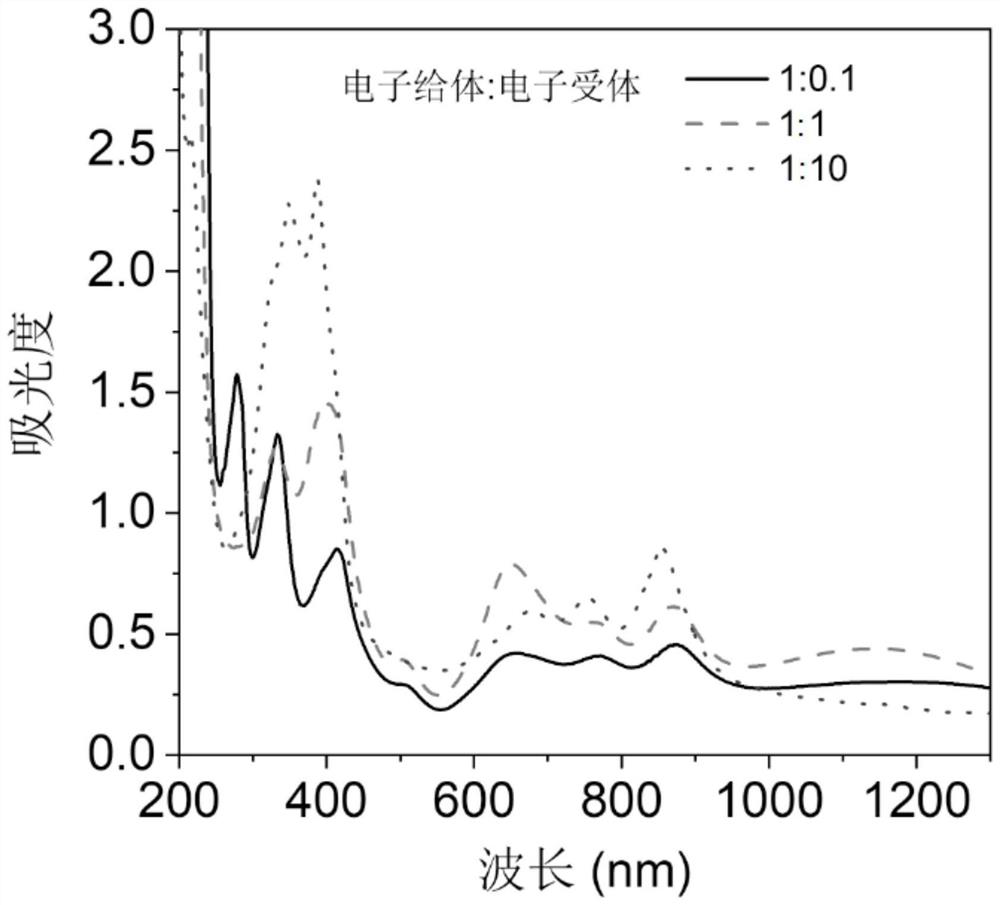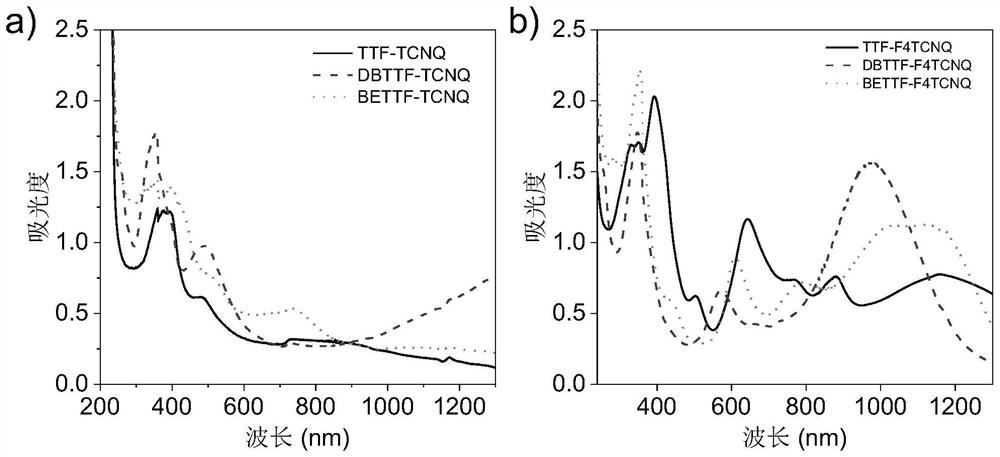Organic metal nanoparticle as well as preparation method and application thereof
A nanoparticle and organometallic technology, applied in the field of organometallic nanoparticles and their preparation, can solve problems such as unpublished reports, and achieve the effects of enhanced water solubility and stability, adjustable optical properties, and simple preparation.
- Summary
- Abstract
- Description
- Claims
- Application Information
AI Technical Summary
Problems solved by technology
Method used
Image
Examples
Embodiment 1
[0058] Example 1: Preparation of TTF-F4TCNQ nanoparticles
[0059] A preparation method of organometallic nanoparticles, comprising the following steps:
[0060] Combine 100 μL of electron donor (40 mM tetrathiafulvalene solution, obtained by dissolving tetrathiafulvalene (TTF) in tetrahydrofuran) with 100 μL of electron acceptor (40 mM 2,3,5,6-tetrafluoro-7, 7',8,8'-tetracyanodimethyl-p-benzoquinone solution, by adding 2,3,5,6-tetrafluoro-7,7',8,8'-tetracyanodimethyl-p-benzoquinone ( F4TCNQ) was dissolved in dimethyl sulfoxide) and mixed well, then 100 μL of surfactant (8mM Poloxamer 188 (F127) solution, obtained by dissolving Poloxamer 188 (F127) in tetrahydrofuran) was added) After mixing evenly, a mixed solution was obtained; the mixed solution was added dropwise to 4 mL of pure water under the condition of vigorous stirring (500 rpm), after stirring for 4 h, dialyzed with a 10 kDa dialysis bag, and dried to obtain organometallic (TTF-F4TCNQ) Nanoparticles. The specific...
Embodiment 2
[0062] This example is basically the same as Example 1, except that the electron donor in this example is 100 μL of 40 mM tetrathiafulvalene solution, and the electron acceptor is 10 μL of 40 mM 2,3,5,6-tetrafluoro-7 ,7',8,8'-tetracyanodimethyl-p-benzoquinone solution, i.e. electron donor: electron acceptor=1:0.1, finally obtained organometallic (TTF-F4TCNQ) nanoparticles;
[0063] This example is basically the same as Example 1, except that the electron donor in this example is 100 μL of 40 mM tetrathiafulvalene solution, and the electron acceptor is 1000 μL of 40 mM 2,3,5,6-tetrafluoro-7 ,7',8,8'-tetracyanodimethyl-p-benzoquinone solution, i.e. electron donor: electron acceptor=1:10, finally obtained organometallic (TTF-F4TCNQ) nanoparticles;
[0064] The TTF-F4TCNQ nanoparticles (electron donor and electron acceptor molar ratios were 1:1, 1:0.1, 1:10) prepared in Example 1 and Example 2 were respectively made into 50 μg / mL TTF-F4TCNQ nanoparticles. For the particle solutio...
Embodiment 3
[0066]Example 3: Preparation of Organometallic Nanoparticle Solution
[0067] The method for preparing organometallic nanoparticles in this example is basically the same as that in Example 1, except that the electron donor and electron acceptor used in this example are shown in Table 1 below:
[0068] Table 1:
[0069]
[0070]
[0071] It was found through experiments that the group A-E can obtain the organometallic (DBTTF-F4TCNQ, BETTF-F4TCNQ, TTF-TCNQ, DBTTF-TCNQ, BETTF-TCNQ) nanoparticles as described in Example 1.
[0072] Performance check:
[0073] The organometallic (TTF-F4TCNQ, DBTTF-F4TCNQ, BETTF-F4TCNQ, TTF-TCNQ, DBTTF-TCNQ, BETTF-TCNQ) nanoparticles prepared in Example 1 and Example 3 were analyzed by UV-Vis-NIR spectroscopy Characterized, the results are as image 3 shown.
[0074] from image 3 It can be seen that the ultraviolet absorption of organometallic nanoparticles with 7,7,8,8-tetracyano-p-quinodimethane (TCNQ) as the electron acceptor is mainl...
PUM
| Property | Measurement | Unit |
|---|---|---|
| photothermal conversion efficiency | aaaaa | aaaaa |
| control rate | aaaaa | aaaaa |
Abstract
Description
Claims
Application Information
 Login to View More
Login to View More - R&D
- Intellectual Property
- Life Sciences
- Materials
- Tech Scout
- Unparalleled Data Quality
- Higher Quality Content
- 60% Fewer Hallucinations
Browse by: Latest US Patents, China's latest patents, Technical Efficacy Thesaurus, Application Domain, Technology Topic, Popular Technical Reports.
© 2025 PatSnap. All rights reserved.Legal|Privacy policy|Modern Slavery Act Transparency Statement|Sitemap|About US| Contact US: help@patsnap.com



